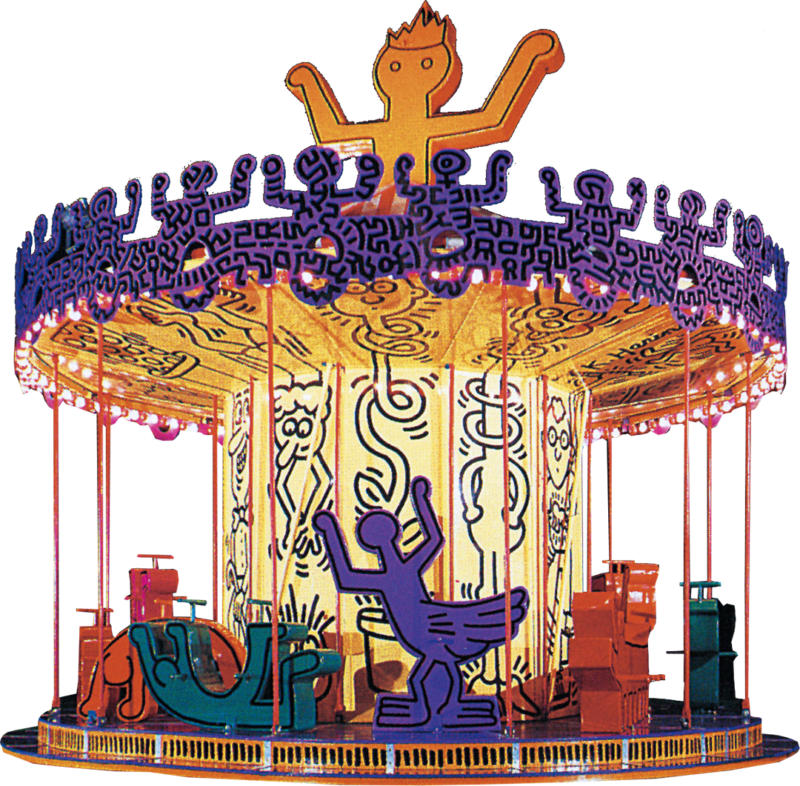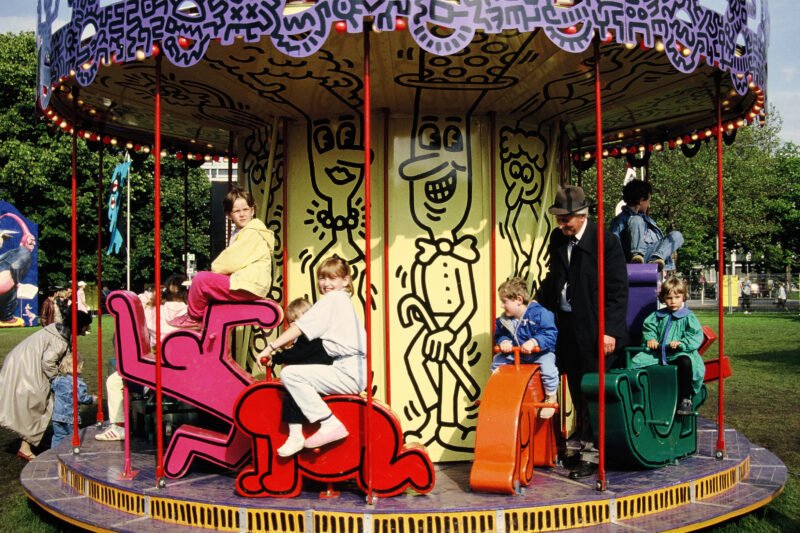
Keith Haring


Keith Haring envisioned a brightly colored carousel featuring seats in bubble-gum pink, lime green, and tangerine orange—three-dimensional versions of the characters from his iconic line drawing. Other characters appeared on large tarps displayed throughout the park.
Artist
Keith Haring
Attraction
Painted carousel
Industrially fabricated tarps
Born
1958, USA
As an art student, Haring made art in public spaces in New York, including painting over advertising panels in subway stations across the city
He executed numerous public murals across New York City and then the world, which touched on social causes and political issues
He used his fame to raise public awareness about AIDS

Keith Haring, Industrially fabricated tarps, Luna Luna, Hamburg, Germany, 1987.

Keith Haring, Painted carousel, Luna Luna, Hamburg, Germany, 1987.
Keith Haring was a painter known for instantly recognizable, pattern-like visual language. Uniting the bright colors of Pop Art, the whimsy of cartoons, and the inventiveness of graffiti, Haring developed a distinct style marked by bold outlines. While studying at the School of Visual Arts in New York, Haring drew inspiration from outside the academy, making friends with legendary artists of the downtown arts scene, including Jean-Michel Basquiat. In 1980, while still a student, he began to draw on top of blank advertisements in subway stations across the city, creating symbols such as a radiant baby, a dancing Everyman, and a barking dog—symbols that became ubiquitous throughout the city and synonymous with his name.


Haring was a highly political artist, engaging with previously taboo subjects like drug abuse, AIDS, gay male sexuality, and nuclear apocalypse.
The energy around these public works made him a local legend, and Haring began exhibiting paintings and other mediums at galleries and museums worldwide. In addition to his fascination with existential themes such as birth, death, love, childhood, sex, and war, Haring was a political artist, engaging with previously taboo subjects like drug abuse, AIDS, gay male sexuality, and nuclear apocalypse. Haring created several murals throughout New York City in the 1980s, including the famous Crack is Wack (1986) mural in East Harlem, which initially led to his arrest before being designated a landmark by the city.


For Luna Luna, Haring envisioned a brightly colored carousel featuring seats in bubble-gum pink, lime green, and tangerine orange—three-dimensional versions of the characters from his iconic line drawing. Other characters appeared on large tarps displayed throughout the park. A self-portrait of Haring holding a paintbrush adorns two panels at the center of the carousel.

Fairground view: Keith Haring, Painted carousel and industrially fabricated tarps, Luna Luna, Hamburg, Germany, 1987.

Fairground view: Keith Haring, Painted carousel and industrially fabricated tarps, Luna Luna, Hamburg, Germany, 1987.
All Haring works © Keith Haring Foundation
Forgotten Fantasy
Thirty-six years ago, Luna Luna landed in Hamburg, Germany: the world’s first art amusement park with rides, games, and attractions by visionaries like Jean-Michel Basquiat, Keith Haring, and David Hockney. By a twist of fate, the park’s treasures were soon sealed in 44 shipping containers and forgotten in Texas—until now.